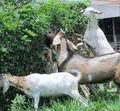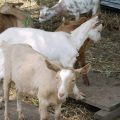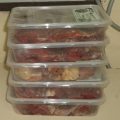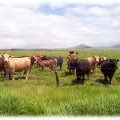Bulacan state college has put up a breeding station that raised goat inventory by 100 percent and aims to aid small farmers meet brisk demand by eventually producing meat loaf from this healthful goat meat.

The Bulacan Agricultural State College (BASC) has put up a nucleus farm and breeding station in its campus. Its increasing goat production is now hoped to be used for the production of high value goat products.
BASC just finished the goat upgrading project financed by the Bureau of Agricultural Research (BAR). The project is beefing up goat inventory in Bulacan by around 100 percent.
BAR is supporting the concept of establishing “multiplier farms” pushed by the BASC, according to BAR Director Nicomedes P. Eleazar. BAR funded the goat upgrading project by P2.4 million.
“We can turn our farmers into entrepreneurs through multiplier farms that upgrade small hold goat farms into agribusiness entities,” said Eleazar.
The production of meat loaf of chevon (the goat meat) is now being pushed under a proposed second phase of the BASC-BAR project.
“Many people are looking for goat meat because it is clean since goats only feed on grasses and vegetation,” said Dr. Helen G. Manalastas, BASC goat project leader.
Bulacan farmers and the project management staff of BASC are learning from the experience of Isabela State University (ISU). Their team also included Dr. Gerardo I. Mendoza, Dr. Junel B. Soriano, and Leah V. Indon.
ISU is now marketing its canned kalderetang kambing, menudo, and kilawin.
But BASC believes there is also a good market for meat loaf which can perhaps borrow a little of the success of global meat brand “Spam.”
Like most meats, chevon is a good source of protein. Other value added products to be generated from goat raising are yoghurt, cheese, goyema (yema), and goatillas (pastillas).
Breeding station
BASC put up a nucleus breeding station on a 0.5 hectare (5,000 square meter) lot at its Institute of Agriculture Newsite campus. It cost around P500,000.
A plantation as source of feed was also established around the breeding station. It grows herbs known to boost health of goats. These are napier grass, star grass and guinea grass; legumes (ornamental peanut and centrosema), shrubs (tricanthera), and indigofera and madre de cacao.
Best goat breeds
The nucleus breeding station primarily improved breeds of native goats in Bulacan. BASC purchased 88 upgraded goats of Anglo Nubian (best for milk production—developed in Great Britain) and Boer (best for meat—developed in South Africa) breeds.
The imported breeds were mated with the native breeds so that their offspring yielded bigger goats with better appearance and higher milk output.
Higher ROI
The BAR project “Meeh Kita! Goat Upgrading and Production in the Villages” has been successful in raising income of farmer-beneficiaries by around 70 percent.
This was shown by a farmer’s return on investment (ROI) of P1,975 per one animal received. It represents a ROI of 62 percent. This was significantly bigger compared to farmers’ net income of only P620 per head when their animals were pure natives. ROI then was just half at 35 percent.
In the nucleus farm, ROI was even higher at 79 percent on a per goat basis.
Sale from a single goat totaled to P5,000 per head. At a cost of P2,786, it generated a net income of P2,213 per head. Not bad at all!
Expense included P843, forage; P348, cost of concentrate; P115, veterinary drugs and supplies; P40 light and water; and P1,440, labor cost.
Goat health
The project taught farmers an integrated goat management that employed all technologies to produce highly marketable animals. It trained farmers on the use of feeds, vitamins and mineral blocks, antibiotics, syringe and needles, forceps and mineral blocks to support animal health needs.
“The project was able to upgrade the native goats originally available in the communities and therefore increase the number of goats available in the project sites and even in the areas surrounding the nucleus farm,” according to a BASC report.
While some smallholder farmers still keep their goats outside in the fields rain or shine, housing is essential for animal health. With housing, mortality is minimal. Over the entire project, there were only six deaths out of 61 goats given to farmer-cooperators.
Livelihood
The project doubled the goat inventory of 61 farmer-cooperators in the trial farms from 160 to 321, a 100 percent increase.
Because of the success of breeding superior goats that produce healthy offspring, the project, which should have lasted for only two years since its implementation in 2009, has sustained up to now.
“Before implementation the total population of goats in the six municipalities of Bulacan covered by the project was 2,837. After the project, total goat population in the areas has increased to 4,047,” said BASC in its terminal report.
The goat sector appears to be minor in the entire livestock sector. Yet, it provides additional income source to many rice and corn farmers, giving livelihood to many Filipinos.
Goats support the livelihood of about 15 million Filipinos across the country today, according to BASC.
Skills
Goats are economical to raise.
“Goats require low maintenance because they eat tree leaves, weeds, grasses, and agricultural by-products,” said BASC.
Because of this, many farmers or aspiring entrepreneurs want to venture into it. But some fail due to the absence of knowledge and skills on raising superior breeds and the absence of available breeder stocks.
Top livestock
In Bulacan, goat is among the top five performing livestock. Goat inventory as of 2005 was 11,280 heads.
These are mostly raised by backyard farmers. Any help in goat raising will therefore aid those that have the least income in livestock raising.
Demand is increasing.
“Goat raising offers positive opportunities. Supply is currently lacking and demand is great. Goat meat is a rare commodity in supermarkets or restaurants, not because it is not desired, but because there is a shortage of supply,” said BASC,
High value products can even generate more income to entrepreneurs.
“Even local dairy products from goat proved to be competitive with the rise of producing yoghurt, sterilized milk and Gouda cheese as among top products.”
Raising the breed can raise income potential.
“By upgrading the breed of my goats, I can price them from P4,000 to P5,000 per head, depending on the grade of the meat. Before, a native goat would be priced a maximum of P1,500 only,” reported the BASC experts.
Higher price
The animal is sold on a per kilo basis of live weight ranging from 20 kilos to 35 kilos. The superior good breeds can be sold at P135 per kilo, while the natives may just be marketable at P120 per kilo.
The BAR-BASC project’s Phase 1 benefited farmers from six Bulacan towns —San Ildefonso, San Miguel, San Rafael, Dona Remedios Trinidad, Angat, and Norzagaray.. The Department of Agriculture and local government units (LGU) of Bulacan helped identify farmer-cooperators.
Strategic plan
Goat production is economically valuable for the Philippines with value rising from P3.3 billion in 2000 to P5.113 billion in 2005.
“While these increments appear small, there was substantial interest in the sector with new farms being set up, increased importation of stocks, and expanding organization of small ruminants (livestock feeding by grazing) nationwide,” according to the Livestock Development Council (LDC).
Goat importation rose about five times from 155 heads in 2001 to 1,330 heads in 2005. Imports come from the US, Australia, and New Zealand.
A Goat Industry Strategic Plan aimed to achieve the following by 2020– reduce pre-weaning mortality from 25 percent to 10 percent; increase slaughter weight from 15 kilos to 30 kilos; bring down kidding (reproduction) interval from nine months to eight months; and raise natural conception rate from 80 percent to 95 percent.
###
For any questions, please call Dr. Helen G. Manalastas, 0926-721-7394; for interview requests, please contact 0916-266-6604.







I started raising goat to my small farm, what i need now is to get some vitamins and medicine since every day is raining, can you help me where can I purchase? I am located here in Cirty of San Jose del Monte Bulacan….Thanks
goat meat loaf